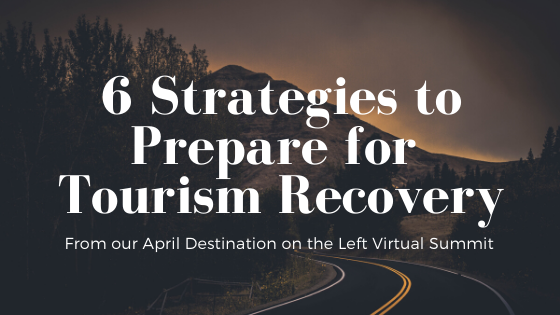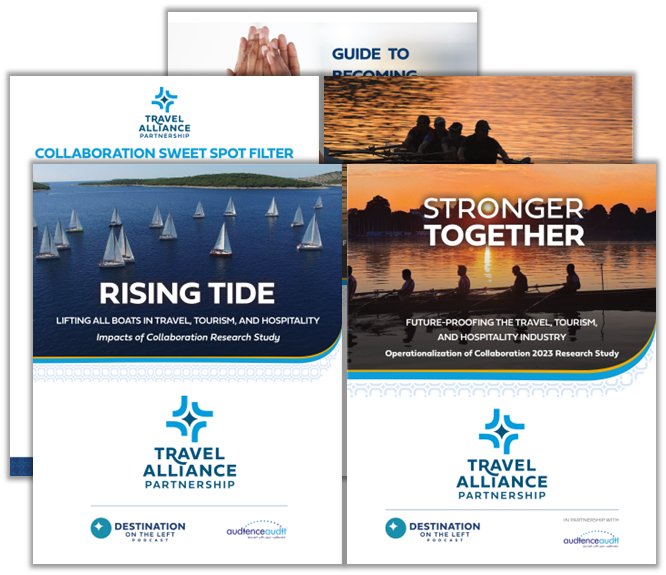6 Strategies to Prepare for Tourism Recovery
From our April 2020 Destination on the Left Virtual Summit
Our second-ever Destination on the Left Virtual Summit kicked off in April 2020 with 12 amazing presenters and three full days of content focused around digital marketing, travel trade and niche marketing within the tourism industry. The topics ranged from food tourism to family travel – but more than that, our presenters tailored many of their topics to focus on necessary shifts that destinations and tourism marketers should be making during the COVID-19 pandemic and what to expect in our “new normal” post-pandemic to prepare for tourism recovery.
There is so much knowledge to be gained from these expert tourism professionals. So we’re rounding up key points they made and the takeaways you can focus on now and in the near future.

Adapt experiences
Right now is a great time to get innovative and prepare by building your community and establishing brand trust within the digital world – Jennifer Barbee, Destination Innovate
Within this pandemic, Barbee notes, we are living in an entirely new digital civilization. The standard digital marketing that we are used to – focusing on a heavy sales message, pushing for overnights and conversions – cannot be the norm. Instead, this time should be about discovery, mentally planning for future trips and learning about new destinations, attractions and resorts. She encourages destinations to think now about experiences that they can offer online (like virtual museum tours or video content) and also about new in-person experiences that they can develop for the future. Online, tourism marketers need to focus their efforts on building a community, engaging with their potential customers and establishing a more personal connection with their target audience. She also suggests the use of Facebook groups as a great way to encourage consumers to authentically engage with your travel brand.
Start a tourism recovery plan
At no time has the economic value of travel and tourism been so clearly seen in local communities – Andria Godfrey, ADARA
The folks at ADARA have been measuring travel sentiment and impact since the COVID-19 pandemic first began in China. They even have a resource center on their website that is updated daily with new travel data. Godfrey notes that these data points lead us to believe that local and regional travel – drive market travel – will be more important than ever as we come out of the pandemic, and that now is the time to prepare. She advises destinations to begin creating a recovery plan and outline steps for a swift rebound, keeping an eye on inflection points to get ahead of the curve as travelers eventually pivot back to hotel overnights and air travel.
Destinations should also consider
- What new drive markets can make the most impact in the short-term
- Looking at seasonality changes as school dates shift and families plan for missed travel over spring break
- Preparing for action in what will quickly become a cluttered marketplace
She advises including stakeholders and partners in a recovery plan and setting measurable goals together, as destinations communicate the value of the DMO as part of community economic recovery efforts.
Hone group travel strategies
The group tour market can take between one and three years to generate consistent business. Now is the time to make a plan. – Sally Berry, Bristol Creek Tourism Consulting
Breaking into the travel trade and group tour market is all about playing a long game, so Berry notes that now is a great time for destinations to create a plan for success and educate themselves about becoming group tour ready. Start by developing a strategy for entering this space that includes:
- A presence at trade shows
- Dedicated outreach to operators and sales calls
- Development of a standard operating procedure (SOP) for staff that will untimely interact with group tours
- A method for tracking group tour specific visitors.
Destinations new to the group market can use this time to educate themselves on popular travel trade lingo, explore tools that are commonly used in the group space (like WeChat) and pick up tips on attracting and booking group tours. This is also a great time to create (or update) tour-specific materials like a profile sheet or brochure, a landing page on the destination’s website and integrate group readiness into an online social media presence.
Engage consumers
If every destination goes to market with “something for everyone” then nothing you have ends up mattering. The narrower your focus, the broader your appeal. – Josiah Brown, The New York Sherpa
After talking to more than 10,000 consumers each year, Brown has reshaped his travel views into a true consumer-first perspective. Often, destinations fall into the trap of marketing in the way they are funded, the way memberships or stakeholders are structured, or by the geography of their region or state. But for consumers, their attention is on location (distance + proximity to major attractions) and the destination’s alignment with personal interests like hiking or craft beverage. Brown encourages destinations to take this time to consider their unique positioning and “be famous for something.” Put a stake in the ground and talk about it on their website and Instagram through direct recommendations and attention-grabbing images. He advises marketers to steer clear of posting “well designed ads” and instead look at the best ways to engage with consumers. As consumers begin to look at planning future trips, they are less likely to put their time or money at risk when traveling, instead considering locations that are famous for something they truly care about.
Prepare health & safety messages and plans
Messaging will need to change in the tourism industry – at least in the short-term – to communicate safety, intimacy and storytelling. – Erik Wolf, World Food Travel
Post-pandemic, Wolf predicts a sudden demand for travel as pent-up consumers begin to re-emerge from their homes. But in order to capture interest immediately, destinations will need to change up their messaging and start planning for a more cautious type of traveler. There will be more need to communicate health and safety measures, in particular to ensure visitors feel safe at various attractions, restaurants, tours or even getting back on an airplane for the first time. Smaller group activities are also more likely to occur, so destinations should consider limiting measures – taking large group experiences down to four or six people instead of the regular 12 or 15. Wolf also encourages marketers to consider and communicate the “why” of a visit or tour, stating “people will be desperate to experience other people again.” He instead encourages destinations to make a real move towards storytelling – giving the stories and faces behind the scenes – instead of just the features of the tour itself.
Tell your story
People don’t buy your product. They buy your story. Invest time and energy into thinking about what that story is. – Glenn Clark, Crafting a Brand
Echoing the sentiments of a few other sessions, Clark dives into branding and storytelling and talks about how important it is now for destinations and attractions to sell their unique story to customers, not just the product they offer. Now is the time for marketers to take a step back and think about the true attractors that drive visitors to select their destination, stay at an accommodation, or dine at a restaurant. He advises tourism professionals to think beyond the sales angle and dive into the who and how – how did your business get started, what makes it different, who are the faces behind the counter, has someone famous visited or stayed there? Without a story, your destination is just another on the list, another bottle of wine, another bed to sleep in.
Keep learning
The April Destination on the Left Virtual Summit came during a time of great change for our nation and our world. But the lessons learned are important keys to helping marketers navigate that change and come out of this pandemic with a strategy, a plan to move forward and the tools to make an impact and stand out in the crowd.
All of our Virtual Summit presentations are available for free until April 30, 2020. Register to view them all at: https://breaktheicemedia.com/podcast/summit/.
Break the Ice Media is also offering a new online course called “Strategic Marketing Planning for Post-Pandemic Recovery.” We’ll take you through the specific steps we use at BTI to create strategic marketing plans for our clients, built out as a 7-week course complete with resources and homework assignments meant to guide you through our process. Sign up today to continue learning and add new skills to your marketing toolkit for tourism recovery!
Author
Related Posts
How Tourism Brand Ambassadors Elevate Your Destination Story
In today’s world, it can seem like everything in marketing and sales has changed. But the one thing that hasn’t changed is the value of...
The Rise of Heritage Travel: Finding Cultural Connections
People often say they are traveling to “find themselves,” and heritage travel is quickly becoming one of the most meaningful ways for travelers to explore…
